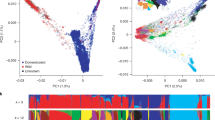Abstract
Spanish barleys constitute a germplasm group of particular interest for breeding purposes, as Spain has been proposed as a possible centre of origin of the crop. The Spanish National Germplasm Bank (Banco Nacional de Germoplasma, BNG), holds a collection of about 2000 barley accessions, mostly landraces collected in Spain prior to extensive introduction of modern varieties. The objective of this work is to create a core collection of barleys representative of old barley genotypes grown in Spain. The core collection will be constituted by three groups of germplasm: successful old varieties (15); entries in common with previously existing barley core collections (15); and 2-row (8) and 6-row (122) entries from the BNG, for a total of 160 entries. Entries were allocated by stratified sampling in agro-ecological uniform zones of barley cultivation in Spain. Classification of agro-ecological regions for barley was based on historical yield records for Spanish provinces. The number of entries for each region was determined in proportion to the logarithm of historical barley acreage. Final choice of accessions within provinces tried to maximize the diversity and avoid duplications by looking at passport data, and to agronomic evaluation data available for a group of about 900 accessions.
Similar content being viewed by others
References
Bockelman H.E., 1996. Developing a barley core subset in the USDA-ARS National Small Grains Collection. In: Skinlared A., G. Scoles & B. Rossnagel (Eds), Proceedings of the V International Oat Conference & VII International Barley Genetics Symposium. Poster Sessions, vol. 1, p. 154. University of Saskatchewan, Saskatoon.
Brown A.H.D., 1989. Core collections: a practical approach to genetic resources management. Genome, 31: 818–824.
Casas, A., E. Igartua, M.P. Vallés, F. Ciudad & J.L. Montoya, 1997. Genetic characterization of barley heading patterns in Spain. EUCARPIA, section Cereals Meeting, Tulln (Austria): 'Application of marker aided selection in cereal breeding programmes', September 21–23.
Ceccarelli S. & S. Grando, 1989. Efficiency of empirical selection under stress conditions. J. of Gen. and Breeding 43: 25–31.
Charmet G. & F. Balfourier, 1995. The use of geostatistics for sampling a core collection of perennial ryegrass populations. Genetic Resources and Crop Evolution 42: 303–309.
Diwan N., M.S. McIntosh & G.R. Bauchan, 1995. Methods of developing a core collection of annual Medicago species. Theor. Appl. Genet. 90: 755–761.
Frankel O.H., 1984. Genetic perspectives on germplasm conservation. In: Arber W., K. Llimensee, W.J. Peacock & P. Starlinger (Eds), Genetic Manipulation: Impact on Man and Society, pp. 161–170. Cambridge University Press, Cambridge UK.
Hadjichristodoulou A., 1995. Evaluation of barley landraces and selections from natural outcrosses of H. vulgare ssp. spontaneum with ssp. vulgare for breeding in semi-arid areas. Genetic Resources and Crop Evolution 42: 83–89.
Knüpffer, H. & Th. J.L.van Hintum, 1995. The Barley Core Collection: an international effort. In: Hodgkin T., A.H.D. Brown, Th. J. L. van Hintum & E. A. V. Morales (Eds), Core Collections of Plant Genetic Resources pp. 171–178, John Wiley & Sons, New York, Chichester, Brisbane, Toronto, Singapore.
MAPA. 1949-1994. Anuario de Estadística Agraria. Publicaciones del Ministerio de Agricultura, Pesca y Alimentación (MAPA). Subdirección General de Estadística, Servicio de Estadísticas Agrarias.
Molina-Cano, J.L., P. Fra-Mon, G. Salcedo, C. Aragoncillo, F. Roca-de-Togores, 1987. Morocco as a possible domestication center for barley: biochemical and agromorphological evidence. Theor. Appl. Genet. 73: 531–536.
Moralejo M., I. Romagosa, G. Salcedo, R. Sánchez-Monge & J.L. Molina-Cano, 1994. On the origin of Spanish two–rowed barleys. Theor. Appl. Genet. 87: 829–836.
Noirot M., S. Hamon & F. Anthony, 1996. The principal component scoring: A new method of constituting a core collection using quantitative data. Genetic Resources and Crop Evolution 43: 1–6.
Peeters J.P. & J.A. Martinelli, 1989. Hierarchical cluster analysis as a tool to manage variation in germplasm collections. Theor. Appl. Genet. 78: 42–48.
SAS Institute. 1989. SAS/STAT Userïs Guide. Version 6, 4th ed. Vol 1 and 2. SAS Inst., Inc., Cary, NC.
Spagnoletti Zeuli P.L. & C.O. Qualset, 1993. Evaluation of five strategies for obtaining a core subset from a large genetic resource collection of durum wheat. Theor. Appl. Genet. 87: 295–304.
van Hintum, Th.J.L., 1996. Core collections in germplasm conservation: evaluation and use. In: Scoles G. & B. Rossnagel (Eds), Proceedings of the V International Oat Conference & VII International Barley Genetics Symposium. Invited Papers, pp. 113–119. University of Saskatchewan, Saskatoon.
Veteläinen M., 1994. Exotic barley germplasm: variation and effects on agronomic traits in complex crosses. Euphytica 79: 127–136.
Author information
Authors and Affiliations
Rights and permissions
About this article
Cite this article
Igartua, E., Gracia, M., Lasa, J. et al. The Spanish barley core collection. Genetic Resources and Crop Evolution 45, 475–481 (1998). https://doi.org/10.1023/A:1008662515059
Issue Date:
DOI: https://doi.org/10.1023/A:1008662515059




